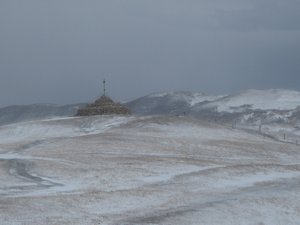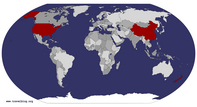Advertisement
Published: April 26th 2010

 Ao'bao
Ao'bao
Lonely snowscape with an ao'bao to guide herders homeChildren of the High Plains
I spent Saturday working until 10pm and couldn't settle down to sleep until well past midnight. I had been prepared to go out with two different sets of friends on Sunday: one outing in the morning, one in the afternoon. Waking up to the sight of sodden streets after a night of rain, I declined the first outing and slept in. It's a good thing I rested up and saved my strength, because the afternoon turned out to be quite an adventure.
All I knew when I woke up on Sunday was that my friend Lulu had invited me to join her family on a mini-expedition; I didn't know where we were headed. I imagined visiting temples in the city limit or something like that. At 2pm I got a phone call telling me that they would be at my home soon, and to "bundle up." I put on my eider-down and stuffed a scarf and a hat into my purse. I was intensely grateful for the hat later, because we drove up into
Da Qing Shan, the mountain range to the north of the city, and the wind was something fierce
once we got into the foothills.
When I heard we we were going to the mountains I had seen in the distance for months, I was thrilled. Lulu's mother and father piloted their vehicle through the country, and Lulu, her roommate Jie and I practiced our poker skills in the backseat.
Once we started to ascend, we got out at regular intervals to take pictures of the increasingly snowy terrain. We were the only people on the mountain; the wind shook the car and Lulu's mother, our expert driver, carefully avoided patches of ice on the road. Lulu's father cracked, "We're perfectly normal, aren't we - out on a day like this?"
The day was a day of two seasons; Lulu's father (also named Sam) called it "Our winter journey in spring." When we first got up to the high fields, where small villages nestle in hollows and horses and other livestock roam freely in the white hills, there was little snow on the ground. But the higher we went, the more it looked as if we had stepped into a scene from a movie set in Siberia. Snow stirred from the ground by sudden gales created
白毛风 - "White wool wind."
By the time we made it to the end of the highway, the snow was beginning to fall. The storm blew in fast, with brilliant patches of blue mottling the white sky where the wind pulled at the veil of clouds. Huhehaote glowed in a pool of sunlight, miles away. Every so often, the cloud cover above us would break and we would be surrounded by the most beautiful sight: a sun-filled snow shower. Sam called it 太阳雪 - Sun Snow.
We stopped at a deserted visitors' center (more signs that we were having our tour in the off-season), and headed on to the end of the road and our goal: a magnificent building high in hills. It is a restaurant built in the shape of a yurt, made from wood, tastefully designed and decorated, and situated above lonely hills, with only the occasional
ao'bao in the distance signalling that humans indeed inhabit this forbidding terrain. We spent some time on the porch of the (closed) restaurant, discussing the architecture of the building and the significance of the
ao'bao we could see in the distance.
The
ao'bao looks very much like a
yurt, with one important difference: it is permanent, made of stone. It serves as both a landmark for herders and as a site for pilgrimage, prayer and worship. Worshippers carry stones to add to the building. They walk around the ao'bao three times counterclockwise as part of their devotions. I found this interesting, because (if I remember correctly) the Apache tribes in North America have similar rules about walking about a round dwelling: one walks counterclockwise, following the path of the sun.
We also played around with the ice and snow, and when we spotted horses out on the fields, we began to call toward them, hoping a herder was nearby who could hear us. There was no herder, but soon the forest service arrived in the form of two young men on a moped, sporting balaclavas and binoculars. They called us down from the porch, and we left soon after a photo op with the startled men.
On our way out, we spotted a small yurt with a motorcycle parked outside. An inviting sight in the snowstorm, we knocked and were admitted by the single tenant, a bespectacled man in his mid-forties. A television with antennae competed
with the sound of the wind tearing past the canvas roof. On our way into the hills, we had discussed the names for Mongolian structures; the yurt is known in local Chinese as the 蒙古包. I had some trouble recalling the English word; the first word that came to mind was "gurt" - I suppose I was combining the Mongolian word "ger" with yurt. I suddenly remembered myself and informed my companions that "yurt" was indeed the correct term.
Inside our host's yurt, we took note of the lattice structure of the walls; the spaces between the interlaced poles make for a convenient way to store small items and tools. The yurt was immaculate and surprsingly comfortable, with two beds, a clean-swept stone floor, and a coal-burning pot-belly stove complete with a stove pipe exiting through the roof. Following the stove pipe, one's eyes are led to the 天窗
tian chuang, skylight. Sealed tight in winter, it can be opened in the summer to cool and light the yurt and let out smoke. I liked Lulu's translation of 天窗: "Window in the sky."
After our tour in the high steppes, we came back to the city to pick
up Lulu's grandmother for dinner. Dinner was at perhaps one of the best places I have been in Huhehaote: a small compound of village-style dwellings that have been converted into private dining rooms. The 炕
kang, a heated platform that would normally serve as a bed, is instead the place to eat; a bench next to the 炕, a round table on the platform and pillows are the only furniture in the room. Sitting on the platform without shoes, with heating underneath and pillows to lean back against, is really a great way to eat.
The food itself was excellent: an appetizer of raw veggies with a spicy dipping sauce, followed by pigs-feet (I passed), roast fish with tofu,
hui cai (a mixed vegetable dish special to Inner Mongolia), and finally steamed bread and soup. We set out again after eating our fill and braving a couple of
baijiu toasts.
Lulu's grandmother was fantastic: she drained her cup easily, listened intently to our conversation, and made pithy comments (in one case describing how the bread looked - very risque) that had me and Lulu and Jie rolling in stitches. She must have been in the mood for fun,

 Che lun
Che lun
Entrance to the visitors' center in the steppes, with giant "che lun" - cart wheelsbecause she asked me to join Lulu and Lulu's mother in coming to her apartment to play
majiang. It probably also helped that they needed a fourth player: Jie went home and Sam went to play cards with his friends.
I played reasonably well but only won once, and instead focused on observing the experts and their reactions. They were very funny; Lulu held her own and the mother and grandmother would *tsk* whenever they picked up a new tile - bluffing, in most cases. We bet using playing cards instead of money; had we used the real thing I would not only be broke but in debt, as well! We stayed up to midnight, and then I was returned home.
I wish I could fully capture how special the day was; it was perfect: spontaneous, adventurous, and light-hearted. Being able to experience leisure time with a Chinese family is a great way to learn the culture, obviously; but it's more than that: it's a way of finding "home" in the faraway. Lulu commented that spending time with me, she was able to see things a little through my eyes, and it made her love her country more.
I think I can safely say that she did the same for me: China feels just a little bit more like my own home.
-Sam
雪日游高原牧场记事:
一天穿越两个季节,从城市的初春到山顶的寒冬,
一辆白色的车载着几个孩子和两个长者去野外谩无目的的踏青。
白雪皑皑的远山,漫天飞舞的雪花,还有肆无忌惮的白毛风。
让孩子们心花怒放喜不自禁。
拍照,高原上留下了一张张快乐的笑脸。
寻梦,雪地里留下一串串勇敢者的足印。
One day passing through two seasons,
From a city's early spring to the cold wintry heights,
A white car carries children and their elders to the country,
With no goal but to roam in the outdoors.
White snow gleams on distant mountains,
Snowflakes dance in the cold sky,
And the unfeeling blizzard also leaves its trace.
May children feel joy, without restraint.
Taking pictures, we yet leave on the plains
The impression of a smiling face.
Following dreams, we leave footsteps
Trailing in a snowy place.
- A poem by Lulu's father about our adventure (my translation in English).
Advertisement
Tot: 0.271s; Tpl: 0.017s; cc: 15; qc: 103; dbt: 0.12s; 1; m:domysql w:travelblog (10.17.0.13); sld: 1;
; mem: 1.4mb





















becky
non-member comment
Lovely journey!
What a lovely blog entry, and beautiful photos... A note re: your Apache comment--"sunwise" is clockwise, the way the sun shining through the skylight moves around the ger during the course of a day. It is also the way that people are traditionally supposed to move around ger and also around the Navajo hogan, sweat lodge and tipi. When one moves around the ao'bao in a counter clockwise direction it is significant because it is opposite the normal sunwise movement. (In shamanic practice, one movement winds energy up or in, and the other unwinds the energy.) Thanks again for your beautiful piece. May you continue to find yourself ever more at home in China, becky kemery Author of "YURTS: Living in the Round" www.yurtinfo.org "Yurtlady" on facebook